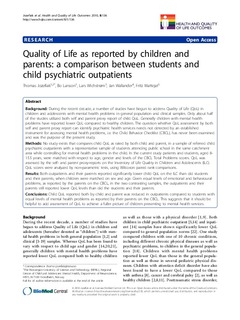| dc.contributor.author | Jozefiak, Thomas | |
| dc.contributor.author | Larsson, Bo Sture | |
| dc.contributor.author | Wichstrøm, Lars | |
| dc.contributor.author | Wallander, Jan | |
| dc.contributor.author | Mattejat, Fritz | |
| dc.date.accessioned | 2015-09-29T12:37:39Z | |
| dc.date.accessioned | 2015-10-22T10:40:21Z | |
| dc.date.available | 2015-09-29T12:37:39Z | |
| dc.date.available | 2015-10-22T10:40:21Z | |
| dc.date.issued | 2010 | |
| dc.identifier.citation | Health and Quality of Life Outcomes 2010, 8(136) | nb_NO |
| dc.identifier.issn | 1477-7525 | |
| dc.identifier.uri | http://hdl.handle.net/11250/2357706 | |
| dc.description.abstract | Background: During the recent decade, a number of studies have begun to address Quality of Life (QoL) in
children and adolescents with mental health problems in general population and clinical samples. Only about half
of the studies utilized both self and parent proxy report of child QoL. Generally children with mental health
problems have reported lower QoL compared to healthy children. The question whether QoL assessment by both
self and parent proxy report can identify psychiatric health services needs not detected by an established
instrument for assessing mental health problems, i.e. the Child Behavior Checklist (CBCL), has never been examined
and was the purpose of the present study.
Methods: No study exists that compares child QoL as rated by both child and parent, in a sample of referred child
psychiatric outpatients with a representative sample of students attending public school in the same catchment
area while controlling for mental health problems in the child. In the current study patients and students, aged 8-
15.5 years, were matched with respect to age, gender and levels of the CBCL Total Problems scores. QoL was
assessed by the self- and parent proxy-reports on the Inventory of Life Quality in Children and Adolescents (ILC).
QoL scores were analyzed by non-parametric tests, using Wilcoxon paired rank comparisons.
Results: Both outpatients and their parents reported significantly lower child QoL on the ILC than did students
and their parents, when children were matched on sex and age. Given equal levels of emotional and behavioural
problems, as reported by the parents on the CBCL, in the two contrasting samples, the outpatients and their
parents still reported lower QoL levels than did the students and their parents.
Conclusions: Child QoL reported both by child and parent was reduced in outpatients compared to students with
equal levels of mental health problems as reported by their parents on the CBCL. This suggests that it should be
helpful to add assessment of QoL to achieve a fuller picture of children presenting to mental health services. | nb_NO |
| dc.language.iso | eng | nb_NO |
| dc.publisher | BioMed Central | nb_NO |
| dc.title | Quality of Life as reported by children and parents: a comparison between students and child psychiatric outpatients | nb_NO |
| dc.type | Journal article | nb_NO |
| dc.type | Peer reviewed | en_GB |
| dc.date.updated | 2015-09-29T12:37:39Z | |
| dc.source.volume | 8 | nb_NO |
| dc.source.journal | Health and Quality of Life Outcomes | nb_NO |
| dc.source.issue | 136 | nb_NO |
| dc.identifier.doi | 10.1186/1477-7525-8-136 | |
| dc.identifier.cristin | 517203 | |
| dc.description.localcode | © 2010 Jozefiak et al; licensee BioMed Central Ltd. This is an Open Access article distributed under the terms of the Creative Commons Attribution License (http://creativecommons.org/licenses/by/2.0), which permits unrestricted use, distribution, and reproduction in any medium, provided the original work is properly cited. | nb_NO |
